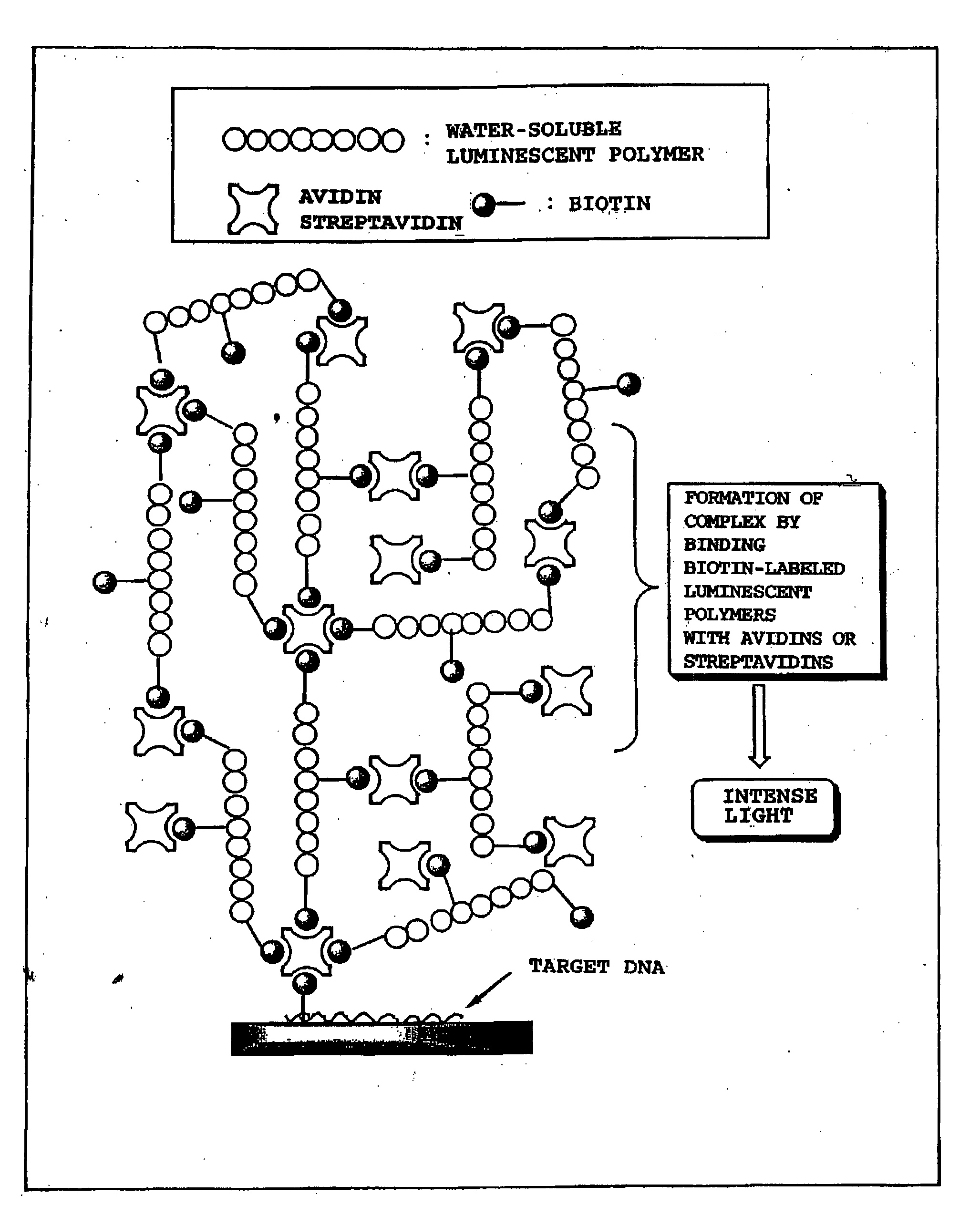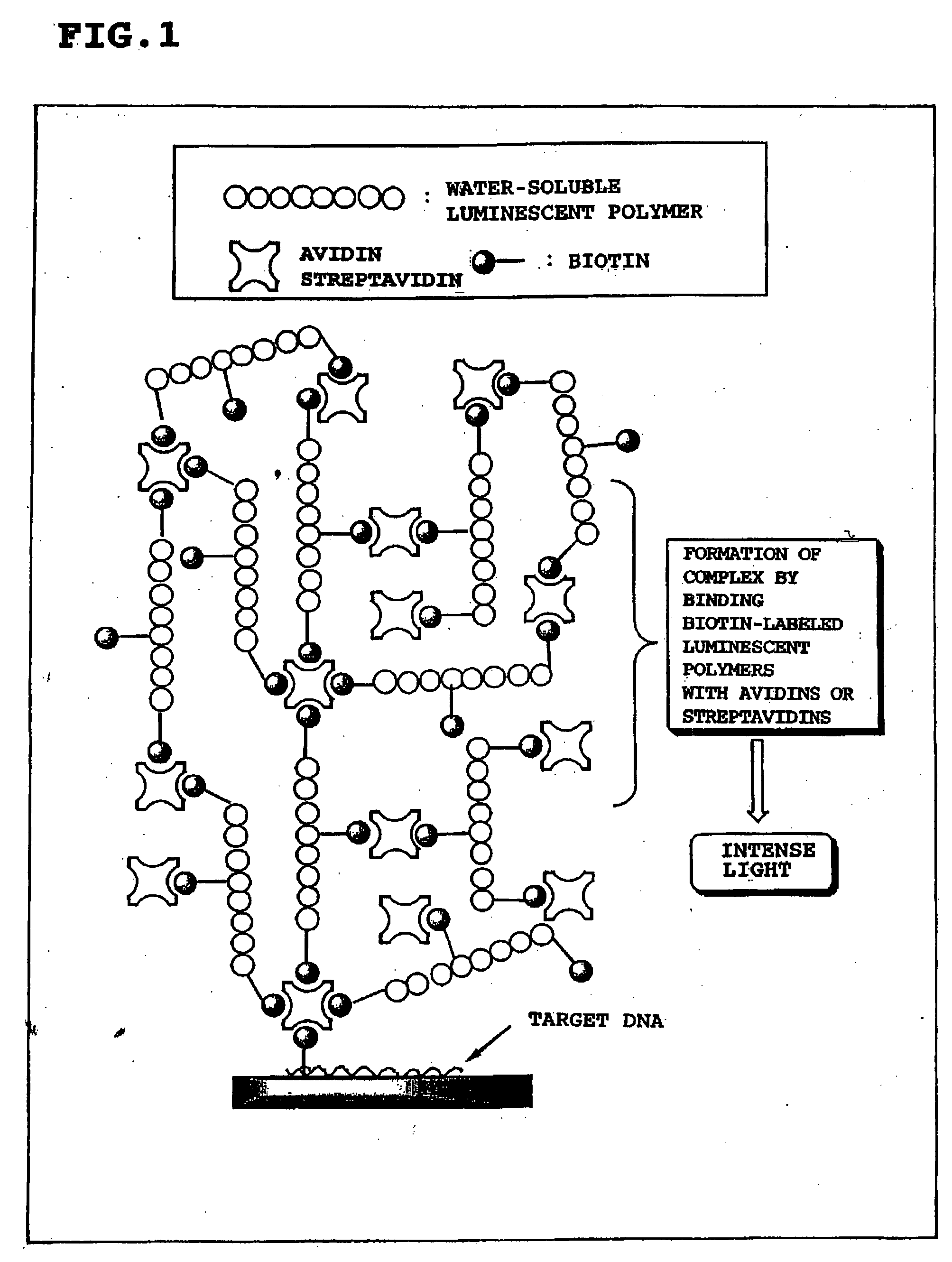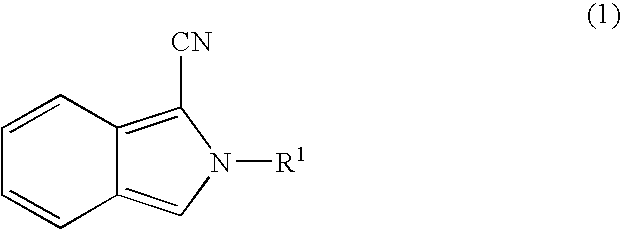Luminescent polymer and use thereof in bioassay
- Summary
- Abstract
- Description
- Claims
- Application Information
AI Technical Summary
Benefits of technology
Problems solved by technology
Method used
Image
Examples
reference example 1
Synthesis of Cyanoisoindoles (1) 4-(2′-cyanoisoindolyl)phenylisothiocyanate [N-(4-isothiocyanatophenyl)-1-cyanoisoindole](i) 4-(2′-cyanoisoindolyl)aniline [N-(4-aminophenyl)-1-cyanoisoindole]
A mixture of 536 mg (4 mmol) of o-phthalaldehyde, 600 mg (4 mmol) of p-aminoacetanilide, and 260 mg (4 mmol) of potassium cyanide was stirred for 90 minutes at room temperature (25 to 28° C.) in a mixed solvent of 1 mL water and 15 mL methanol. The insoluble product (compound I) thus produced was removed by filtration and washed with 5 mL of cold methanol. This compound I was suspended in 60 mL of ethanol and refluxed for 10 hours in the presence of 30 mL of 1 M hydrochloric acid. The reaction mixture was concentrated in vacuo to obtain the titled 4-(2′-cyanoisoindolyl)aniline expressed by the following formula in the form of a colorless, bright, crystalline powder (compound II, approximately 100 mg).
[Thirty-Fifth Chemical Formula]
(ii) 4-(2′-cyanoisoindolyl)phenylisothiocyanate [N-(4-isothio...
example 1
Water-Soluble Luminescent Polymer (Polyamino Acid)
(1-1) Polylysine to which 1.64-(2′-cyanoisoindolyl)phenyl-isothiocyanate Molecules are Attached (Luminescent Polymer (1))
56 mg (54 μmol) of polylysine (a 5 oligomer of lysine; poly(L-Lys)5.5HBr; average molecular weight 1045) was dissolved in 2 mL of water, 30 mL of pyridine and 79 mg (287 μmol) of 4-(2′-cyanoisoindolyl)phenylisothiocyanate were added to the solution, and the mixture was heated for 30 minutes at 50° C., after which the solvent was distilled away from the reaction solution under reduced pressure. The residue was dissolved in 50 mL of a mixture of acetonitrile and water (45:55, % v / v), and the solution was injected into a preparative gel column (Sephadex LH 20) and separated with an eluent consisting of acetonitrile and water (45:55, % v / v). The fluorescent peak originating in the 4-(2′-cyanoisoindolyl)phenyl group (4-[2-(1′-cyanoisoindolyl)]phenyl group) expressed by the following formula was traced, and a fractio...
example 2
Water-Soluble Luminescent Polymer (Polysaccharide, Part 1)
♦ Dextran to which Thirty 4-(2′-cyanoisoindolyl)aniline Molecules are Attached (Luminescent Polymer (3))
470 mg (28 μmol) of dextran (average molecular weight 16,800: an average of 104 glucoses are polymerized) was dissolved in 10 mL of water, 381 mg (1.8 mmol) of sodium periodate was added to the solution, and the mixture was stirred for 40 minutes at room temperature. This reaction oxidized approximately 30% of the glucoses in the dextran. 15 mL of water was added to this reaction solution, and the obtained solution was fallen in drops into 250 mL of methanol. The precipitated oxidized dextran was recovered by filtration and dried under reduced pressure (yield of the oxidized dextran: 410 mg). 50 mg thereof was dissolved in 6 mL of ethylene glycol, this solution was mixed with a solution obtained by dissolving 98 mg (420 μmol) of 4-(2′-cyanoisoindolyl)aniline in 3 mL of tetrahydrofuran, and this mixture was stirred for 24...
PUM
| Property | Measurement | Unit |
|---|---|---|
| Wavelength | aaaaa | aaaaa |
| Wavelength | aaaaa | aaaaa |
| Solubility (mass) | aaaaa | aaaaa |
Abstract
Description
Claims
Application Information
 Login to View More
Login to View More - R&D
- Intellectual Property
- Life Sciences
- Materials
- Tech Scout
- Unparalleled Data Quality
- Higher Quality Content
- 60% Fewer Hallucinations
Browse by: Latest US Patents, China's latest patents, Technical Efficacy Thesaurus, Application Domain, Technology Topic, Popular Technical Reports.
© 2025 PatSnap. All rights reserved.Legal|Privacy policy|Modern Slavery Act Transparency Statement|Sitemap|About US| Contact US: help@patsnap.com



